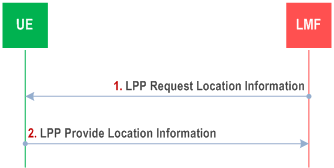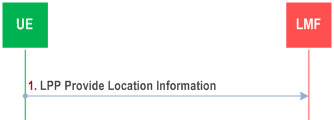Content for TS 38.305 Word version: 18.1.0
1…
4…
5…
6…
6.5…
6.7…
7…
7.3A…
7.4…
7.6…
7.11…
7.12…
8…
8.1.2.1a…
8.1.3…
8.2…
8.3…
8.4…
8.5…
8.6…
8.7…
8.8…
8.9…
8.10…
8.11…
8.12…
8.13…
8.14…
8.15…
A…
8.8 Motion sensor positioning method
8.8.1 General
8.8.2 Information to be transferred between NG-RAN/5GC Elements
8.8.2.1 General
8.8.2.2 Information that may be transferred from the UE to LMF
8.8.2.2.0 General
8.8.2.2.1 UE-assisted, UE-based, Standalone mode
8.8.2.2.2 UE Displacement and Movement Information
8.8.2.3 Information that may be transferred from the LMF to the UE
8.8.3 Motion Sensors Location Information Transfer Procedure
8.8.3.1 General
8.8.3.2 LMF initiated Location Information Transfer Procedure
8.8.3.3 UE-initiated Location Information Delivery Procedure
...
...
8.8 Motion sensor positioning method p. 119
8.8.1 General p. 119
Motion sensors can be used to estimate the location of the UE. With the combination of other positioning methods (hybrid) a more accurate position of the UE can be computed. UE using one or more motion sensors provides the movement information. The movement information comprises displacement results estimated as an ordered series of points.
The positioning modes supported are UE-Assisted, UE-Based, and Standalone.
8.8.2 Information to be transferred between NG-RAN/5GC Elements p. 119
8.8.2.1 General p. 119
This clause defines the information (e.g., assistance data, position and/or measurement data) that may be transferred between NG-RAN/5GC elements.
8.8.2.2 Information that may be transferred from the UE to LMF p. 119
8.8.2.2.0 General |R18| p. 119
The information transferred from the UE to the LMF consists of capability information and location measurements or UE position. The supported information elements are given in Table 8.8.2.2.0-1.


| Information | UE-assisted | UE-based / Standalone |
|---|---|---|
| Displacement Timestamp | Yes | Yes |
| Displacement Information | Yes | Yes |
| Reference Position | Yes | Yes |
| Reference Time | Yes | Yes |
8.8.2.2.1 UE-assisted, UE-based, Standalone mode p. 120
In the UE-assisted, UE-Based, and Standalone mode, the UE reports, displacement information, displacement timestamp, reference position and reference time.
8.8.2.2.2 UE Displacement and Movement Information p. 120
The UE may report movement and displacement information which comprises an ordered series of direction, distance travelled by the target device and the time intervals when these measurements are taken.
8.8.2.3 Information that may be transferred from the LMF to the UE p. 120
In this release, no information, e.g. assistance data is transferred to the UE.
8.8.3 Motion Sensors Location Information Transfer Procedure p. 120
8.8.3.1 General p. 120
The purpose of this procedure is to enable the LMF to request additional sensor measurements or to enable the UE to provide sensor measurements to the LMF for position calculation.
8.8.3.2 LMF initiated Location Information Transfer Procedure p. 120
Figure 8.8.3.2-1 shows the Location Information Transfer operations when the procedure is initiated by the LMF.

Step 1.
The LMF sends a LPP Request Location Information message to the UE for invocation of motion sensor positioning. This request includes positioning instructions such as the positioning mode, specific requested UE measurements if any, and quality of service parameters (accuracy, response time).
Step 2.
The UE performs the requested measurements. The UE sends an LPP Provide Location Information message to the LMF before the Response Time provided in step (1) elapsed. If the UE is unable to perform the requested measurements, or if the Response Time provided in step 1 elapsed before any of the requested measurements have been obtained, the UE returns any information that can be provided in an LPP message of type Provide Location Information which includes a cause indication for the not provided location information.
8.8.3.3 UE-initiated Location Information Delivery Procedure p. 120
Figure 8.8.3.3-1 shows the Location Information delivery operations for motion sensor method when the procedure is initiated by the UE.

Step 1.
The UE sends an LPP Provide Location Information message to the LMF. The Provide Location Information message may include UE sensor measurements or location estimate already available at the UE.